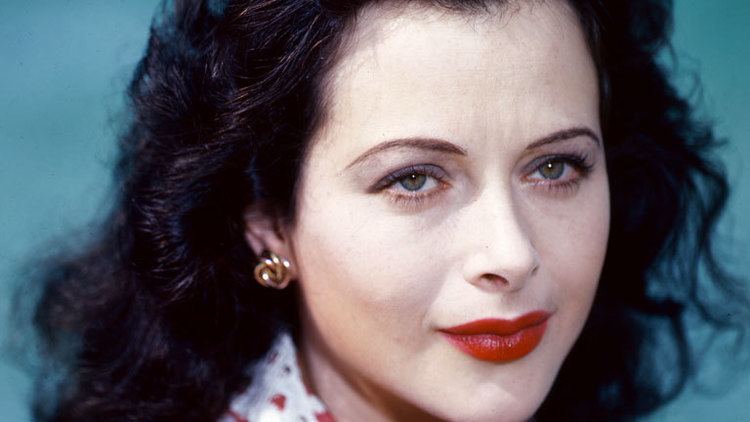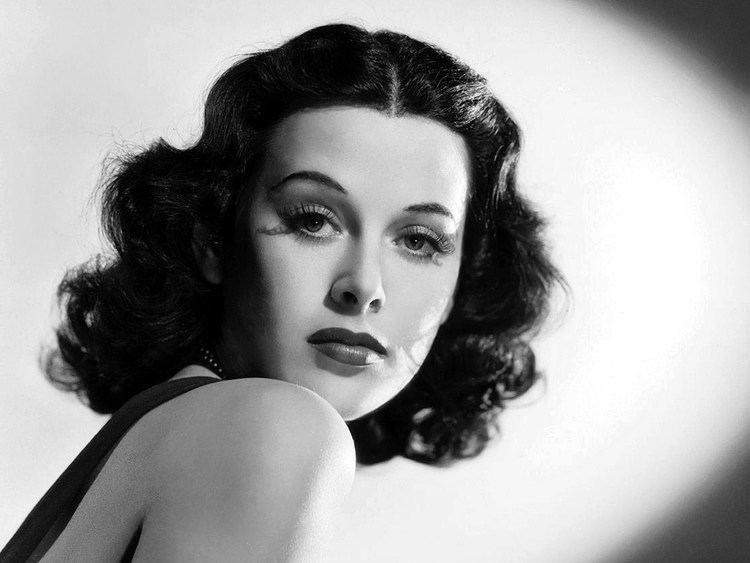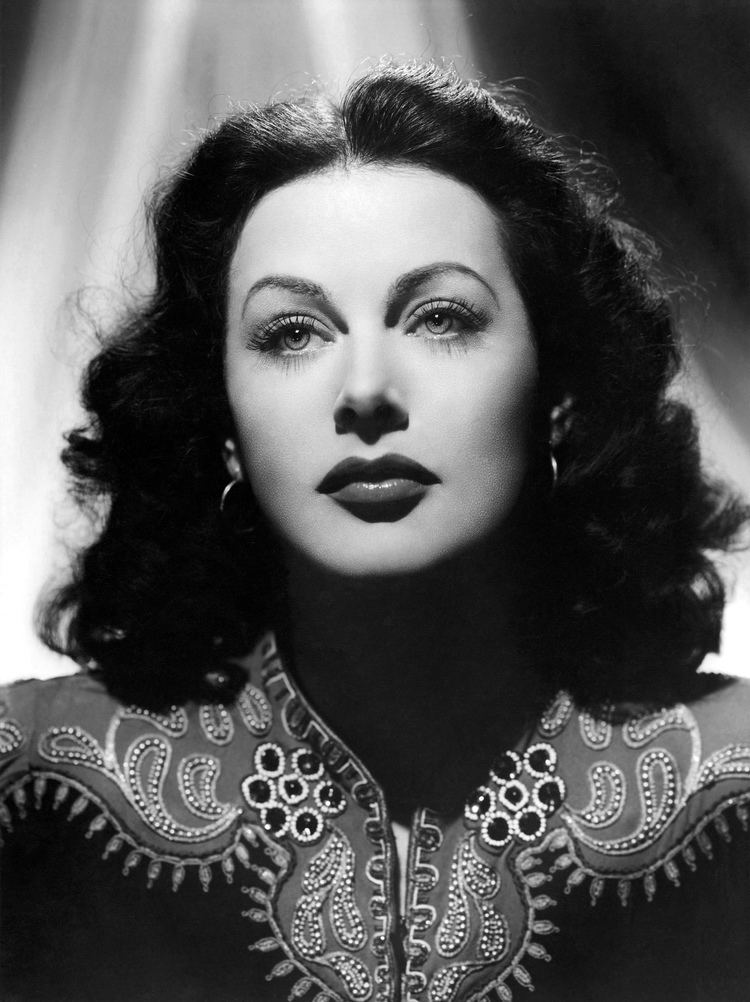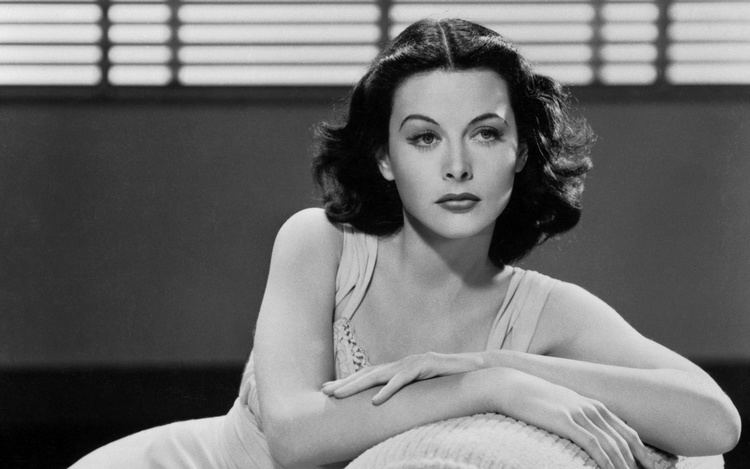Occupation Actress, inventor Years active 1930–1958 | Name Hedy Lamarr Role Film actress | |
 | ||
Full Name Hedwig Eva Maria Kiesler Citizenship AustriaUnited States (from 1953) Spouse Lewis J. Boies (m. 1963–1965) Children Anthony Loder, Denise Loder, James Lamarr Markey Movies Ecstasy, Samson and Delilah, Algiers, Ziegfeld Girl, The Strange Woman Similar People | ||
Hedy lamarr the other side of the screen siren
Hedy Lamarr (; born Hedwig Eva Maria Kiesler, November 9, 1914 – January 19, 2000) was an Austrian and American film actress and inventor.
Contents
- Hedy lamarr the other side of the screen siren
- Hedy lamarr google doodle 101st birthday of actress and inventor
- Early life and European film career
- First marriage
- Hollywood actress
- Inventor
- Wartime fundraiser
- Later years
- Later media appearances
- In popular culture
- Marriages
- Death
- Filmography
- References

After an early and brief film career in Czechoslovakia that included the controversial film Ecstasy (1933 – in which Lamarr is very briefly seen swimming in the nude and running naked), she fled from her husband, a wealthy Austrian ammunition manufacturer, and secretly moved to Paris. There, she met MGM head Louis B. Mayer, who offered her a movie contract in Hollywood, where she became a film star from the late 1930s to the 1950s.

Lamarr appeared in numerous popular feature films, including Algiers (1938), I Take This Woman (1940), Comrade X (1940), Come Live With Me (1941), H.M. Pulham, Esq. (1941), and Samson and Delilah (1949).

At the beginning of World War II, Lamarr and composer George Antheil developed a radio guidance system for Allied torpedoes, which used spread spectrum and frequency hopping technology to defeat the threat of jamming by the Axis powers. Although the US Navy did not adopt the technology until the 1960s, the principles of their work are now incorporated into modern Wi-Fi, CDMA, and Bluetooth technology, and this work led to their induction into the National Inventors Hall of Fame in 2014.

Hedy lamarr google doodle 101st birthday of actress and inventor
Early life and European film career
Lamarr was born Hedwig Eva Maria Kiesler in 1914 in Vienna, Austria-Hungary, the only child of Gertrud "Trude" Kiesler (née Lichtwitz; 1894–1977) and Emil Kiesler (1880–1935). Her father was born to a Jewish family in Lemberg (now Lviv in Ukraine) and was a successful bank director.

Her mother Gertrud was a pianist and Budapest native who came from an upper-class Jewish family; she had converted from Judaism to Catholicism and was described as a "practicing Christian", who raised her daughter as a Christian. Lamarr helped get her mother out of Austria (then under Nazi domination) and to the United States. Her mother later became an American citizen. Gertrud Kiesler put "Hebrew" as her race on her petition for naturalization as an American citizen.
In the late 1920s, Lamarr was discovered as an actress and brought to Berlin by producer Max Reinhardt. Following her training in the theater, she returned to Vienna to work in the film industry, first as a script girl, and soon as an actress. In early 1933, at age 18, she starred in Gustav Machatý's film, Ecstasy (Ekstase in German, Extase in Czech), which was filmed in Prague. Her role was that of a neglected young wife married to an indifferent older man. The film became both celebrated and notorious for showing Lamarr's face in the throes of orgasm as well as close-up and brief nude scenes, a result of her being "duped" by the director and producer, who used high-power telephoto lenses.
Although she was dismayed and now disillusioned about taking other roles, the film gained world recognition after winning an award in Rome. Throughout Europe the film was considered an artistic work, while in America it was considered overly sexual and received negative publicity, especially among women's groups.
Lamarr went on to play a number of stage roles, including a starring one in Sissy, a play produced in Vienna, which won accolades from critics. Admirers sent roses to her dressing room and tried to get backstage to meet her. She sent most of them away, including a man who was more insistent, Friedrich Mandl. He became obsessed with getting to know her. She fell for his charming and fascinating personality, partly due to his immense financial status. Her parents, both of Jewish descent, did not approve, due to Mandl's ties to Mussolini and, later, Hitler, but could not stop the headstrong Hedy.
First marriage
On August 10, 1933, Lamarr married Mandl, an Austrian military arms merchant and munitions manufacturer who was reputedly the third-richest man in Austria. She was 18 years old and he was 33. In her autobiography Ecstasy and Me, Lamarr described Mandl as an extremely controlling husband who strongly objected to her simulated orgasm scene in Ecstasy and prevented her from pursuing her acting career. She claimed she was kept a virtual prisoner in their castle home, Schloss Schwarzenau.
Mandl had close social and business ties to the fascist government of Italy, selling munitions to Mussolini, and, although, like Hedy, his own father was Jewish, had ties to the Nazi government of Germany as well. Lamarr wrote that Mussolini and Hitler attended lavish parties at the Mandl home. Lamarr accompanied Mandl to business meetings, where he conferred with scientists and other professionals involved in military technology. These conferences were her introduction to the field of applied science and nurtured her latent talent in science.
Lamarr's marriage to Mandl eventually became unbearable, and she decided to separate herself from both him and her country. In her autobiography, she wrote that she disguised herself as her maid and fled to Paris; but by other accounts, she persuaded Mandl to let her wear all of her jewelry for a dinner party, then disappeared afterward. She writes about her marriage:
I knew very soon that I could never be an actress while I was his wife.... He was the absolute monarch in his marriage.... I was like a doll. I was like a thing, some object of art which had to be guarded—and imprisoned—having no mind, no life of its own.
Hollywood actress
After arriving in Paris in 1937, she met Louis B. Mayer, who was scouting for talent in Europe. Mayer persuaded her to change her name to Hedy Lamarr (she had been known as "the Ecstasy lady"), choosing the surname in homage to the beautiful silent film star, Barbara La Marr. He brought her to Hollywood in 1938 and began promoting her as the "world's most beautiful woman".
Lamarr made her American film debut in Algiers (1938), opposite Charles Boyer. The film created a "national sensation," says Shearer. She was billed as an unknown but well-publicized Austrian actress, which created anticipation in audiences. Mayer hoped she would become another Greta Garbo or Marlene Dietrich. According to one viewer, when her face first appeared on the screen, "everyone gasped...Lamarr's beauty literally took one's breath away."
In future Hollywood films, she was invariably typecast as the archetypal glamorous seductress of exotic origin. Lamarr played opposite the era's most popular leading men. Her many films included Boom Town (1940) with Clark Gable and Spencer Tracy, Comrade X with Gable, White Cargo (1942), Tortilla Flat (1942) with Tracy and John Garfield, H. M. Pulham, Esq. (1941) with Robert Young, and Dishonored Lady (1947). In 1941, Lamarr was cast alongside Lana Turner and Judy Garland in Ziegfeld Girl.
Her off-screen life and personality during those years was quite different from what audiences assumed. She spent much of her time feeling lonely and homesick. She might swim at her agent's pool, but shunned the beaches and staring crowds. When asked for an autograph, she wondered why anyone would want it. Writer Howard Sharpe interviewed her and gave his impression:
Hedy has the most incredible personal sophistication. She knows the peculiarly European art of being womanly; she knows what men want in a beautiful woman, what attracts them; and she forces herself to be these things. She has magnetism with warmth, something that neither Dietrich nor Garbo has managed to achieve.
Lamarr made 18 films from 1940-49, and had two children during that time (in 1945 and 1947). After leaving MGM in 1945, she enjoyed her biggest success as Delilah in Cecil B. DeMille's Samson and Delilah, the highest-grossing film of 1949, with Victor Mature as the Biblical strongman. Following a comedic role opposite Bob Hope in My Favorite Spy (1951), her career went into decline. She appeared only sporadically in films after 1950, one of her last roles being that of Joan of Arc in Irwin Allen's critically panned epic, The Story of Mankind (1957). White Cargo, one of Lamarr's biggest hits at MGM, contains arguably her most memorable film quote, delivered with provocative invitation: "I am Tondelayo. I make tiffin for you?" This line typifies many of Lamarr's roles, which emphasized her beauty and sensuality while giving her relatively few lines. The lack of acting challenges bored Lamarr. She reportedly took up inventing to relieve her boredom.
Author Richard Rhodes describes her assimilation into American culture:
Of all the European émigrés who escaped Nazi Germany and Nazi Austria, she was one of the very few who succeeded in moving to another culture and becoming a full-fledged star herself. There were so very few who could make the transition linguistically or culturally. She really was a resourceful human being–I think because of her father’s strong influence on her as a child.
Inventor
Although Lamarr had no formal training and was primarily self-taught, she worked in her spare time on various hobbies and inventions, which included an improved traffic stoplight and a tablet that would dissolve in water to create a carbonated drink. The beverage was unsuccessful; Lamarr herself said it tasted like Alka-Seltzer.
Among the few who knew of Lamarr's inclination to inventiveness was aviation tycoon Howard Hughes. Lamarr discussed her relationship with Hughes during an interview, saying that while they dated he actively supported her "tinkering" hobbies. He put his team of science engineers at her disposal, saying they would do or make anything she asked for.
On one occasion, Hughes was trying to modify his aircraft designs to make planes fly faster. He asked her for ideas; "He relied on me," she said. Lamarr began studying the aerodynamics of birds and the shapes of fishes, afterward presenting him with sketched ideas to make wings on planes less square and more efficient. "[I] showed it to Howard Hughes and he said, 'You're a genius.'"
During World War II, Lamarr learned that radio-controlled torpedoes, which could be important in the naval war, could easily be jammed, thereby causing the torpedo to go off course. With the knowledge she had gained about torpedoes from her first husband, she came up with the idea of somehow creating a frequency-hopping signal that could not be tracked or jammed. She contacted her friend, composer and pianist George Antheil, to help her develop a device for doing that, and he succeeded by synchronizing a miniaturized player-piano mechanism with radio signals. They drafted designs for the frequency-hopping system, which they patented. Antheil recalls:
We began talking about the war, which, in the late summer of 1940, was looking most extremely black. Hedy said that she did not feel very comfortable, sitting there in Hollywood and making lots of money when things were in such a state. She said that she knew a good deal about munitions and various secret weapons ... and that she was thinking seriously of quitting M.G.M. and going to Washington, D.C., to offer her services to the newly established Inventors’ Council.
Their invention was granted a patent on August 11, 1942 (filed using her married name Hedy Kiesler Markey). However, it was technologically difficult to implement, and at that time the U.S. Navy was not receptive to considering inventions coming from outside the military. Only in 1962 (at the time of the Cuban missile crisis) did an updated version of their design appear on Navy ships.
In 1997, they received the Electronic Frontier Foundation Pioneer Award and the Bulbie Gnass Spirit of Achievement Bronze Award, given to individuals whose creative lifetime achievements in the arts, sciences, business, or invention fields have significantly contributed to society. She was featured on the Science Channel and the Discovery Channel. In 2014, Lamarr and Antheil were posthumously inducted into the National Inventors Hall of Fame.
Wartime fundraiser
Lamarr wanted to join the National Inventors Council, but was reportedly told by NIC member Charles F. Kettering and others that she could better help the war effort by using her celebrity status to sell war bonds.
She participated in a war bond selling campaign with a sailor named Eddie Rhodes. Rhodes was in the crowd at each Lamarr appearance, and she would call him up on stage. She would briefly flirt with him before asking the audience if she should give him a kiss. The crowd would of course say yes, to which Hedy would reply that she would if enough people bought war bonds. After enough bonds were purchased, she would give Rhodes his kiss, and he would head back into the audience. Then they would head off to the next war bond rally.
Later years
Lamarr became a naturalized citizen of the United States at age 38 on April 10, 1953. Her autobiography, Ecstasy and Me, was published in 1966, although she said on TV that it was not actually written by her, and much of it was fictional. Lamarr later sued the publisher, saying that many details were fabricated by its ghost writer, Leo Guild. Lamarr, in turn, was sued by Gene Ringgold, who asserted that the book plagiarized material from an article he had written in 1965 for Screen Facts, a magazine.
In 1966 she was arrested in Los Angeles for shoplifting. The charges were eventually dropped. In 1991 she was arrested on the same charge in Florida, this time for stealing $21.48 worth of laxatives and eye drops. She pleaded "no contest" to avoid a court appearance, and the charges were once again dropped in return for a promise to refrain from breaking any laws for a year. The shoplifting charges coincided with a failed attempt to return to the screen.
The 1970s was a decade of increasing seclusion for Lamarr. She was offered several scripts, television commercials, and stage projects, but none piqued her interest. In 1974, she filed a $10 million lawsuit against Warner Bros., claiming that the running parody of her name ("Hedley Lamarr") in the Mel Brooks comedy Blazing Saddles infringed her right to privacy. Brooks said he was flattered; the studio settled out of court for an undisclosed nominal sum and an apology to Lamarr for “almost using her name". Brooks said that Lamarr "never got the joke". With her eyesight failing, Lamarr retreated from public life and settled in Miami Beach, Florida, in 1981.
For several years beginning in 1997, the boxes of CorelDRAW’s software suites were graced by a large Corel-drawn image of Lamarr. The picture won CorelDRAW’s yearly software suite cover design contest in 1996. Lamarr sued Corel for using the image without her permission. Corel countered that she did not own rights to the image. The parties reached an undisclosed settlement in 1998.
For her contribution to the motion picture industry, Lamarr has a star on the Hollywood Walk of Fame at 6247 Hollywood Blvd adjacent to Vine St where the Walk is centered.
In her later years, Lamarr turned to plastic surgery to preserve the looks she was terrified of losing, but the results were disastrous. "She had her breasts enlarged, her cheeks raised, her lips made bigger, and much, much more," said her son, Anthony. "She had plastic surgery thinking it could revive her looks and her career, but it backfired and distorted her beauty". Anthony Loder also claimed that Lamarr was addicted to pills.
Lamarr became estranged from her adopted son, James Lamarr Loder, when he was 12 years old. Their relationship ended abruptly and he moved in with another family. They did not speak again for almost 50 years. Lamarr left James Loder out of her will and he sued for control of the US$3.3 million estate left by Lamarr in 2000. He eventually settled for US$50,000.
Later media appearances
In the last decades of her life, the telephone became her only means of communication with the outside world, even with her children and close friends. She often talked up to six or seven hours a day on the phone, but she hardly spent any time with anyone in person in her final years. A documentary, Calling Hedy Lamarr, was released in 2004 and featured her children, Anthony Loder and Denise Loder-DeLuca.
In popular culture
An off-Broadway play, Frequency Hopping, features the lives of Lamarr and Antheil. The play was written and staged by Elyse Singer in 2008, and the script won a prize for best new play about science and technology from STAGE.
The 2010 New York Public Library exhibit, Thirty Years of Photography at the New York Public Library, included a photo of a topless Lamarr (c. 1930) by Austrian-born American photographer Trude Fleischmann.
The story of Lamarr's frequency-hopping spread-spectrum invention was explored in an episode of the Science Channel show Dark Matters: Twisted But True, a series that explores the darker side of scientific discovery and experimentation, which premiered on September 7, 2011. Her work in improving wireless security was part of the premiere episode of the Discovery Channel show How We Invented the World.
Anne Hathaway said her portrayal of Catwoman in the 2012 film The Dark Knight Rises was based on Lamarr.
On May 20, 2010, Lamarr was selected out of 150 IT people to be featured in a short film launched by the British Computer Society (BCS).
On November 9, 2015, the 101st anniversary of her birth, Google paid tribute to Hedy Lamarr's work in film and her contributions to scientific advancement with an animated Google Doodle.
In 2016, Lamarr was depicted in an off-Broadway play, HEDY! The Life and Inventions of Hedy Lamarr, a one-woman show written and performed by Heather Massie.
Also during 2016, the main villain in Agent Carter (season 2) (set in late 1940s), Whitney Frost, was a character modeled after Lamarr.
In 2017, Bombshell: The Hedy Lamarr Story, produced by Susan Sarandon, a documentary about Lamarr's career as an actress and later as an inventor, will premiere at the 2017 Tribeca Film Festival.
Marriages
Lamarr was married and divorced six times. She adopted a son, James, in 1941, during her second marriage to Gene Markey. She went on to have two biological children, Denise (born 1945) and Anthony (born 1947), with her third husband, actor John Loder, who also adopted James. The following is a list of her marriages:
- Friedrich Mandl (married 1933–1937), chairman of the Hirtenberger Patronen-Fabrik.
- Gene Markey (married 1939–1941), screenwriter and producer. Child: James Lamarr Markey (born January 9, 1939), adopted June 12, 1939, and re-adopted by John Loder; the child was thereafter known as James Lamarr Loder. The couple lived at 2727 Benedict Canyon Drive in Beverly Hills, California during their marriage.
- John Loder (married 1943–1947), actor. Children: Denise Loder (born January 19, 1945), married Larry Colton, a writer and former baseball player, and Anthony Loder (born February 1, 1947), married Roxanne who worked for illustrator James McMullan. Anthony Loder was featured in the 2004 documentary film Calling Hedy Lamarr.
- Ernest "Ted" Stauffer (married 1951–1952), nightclub owner, restaurateur, and former bandleader.
- W. Howard Lee (married 1953–1960); a Texas oilman (who later married film actress Gene Tierney).
- Lewis J. Boies (married 1963–1965); Lamarr's own divorce lawyer.
Following her sixth and final divorce in 1965, Lamarr remained single for the last 35 years of her life.
Death
Lamarr died in Casselberry, Florida on January 19, 2000, aged 85. Her death certificate cited three causes: heart failure, chronic valvular heart disease, and arteriosclerotic heart disease. Her death coincided with her daughter Denise's 55th birthday. Her son Anthony Loder took her ashes to Austria and spread them in the Vienna Woods, in accordance with her last wishes.
Lamarr was given an honorary grave in Vienna's Central Cemetery in 2014.
